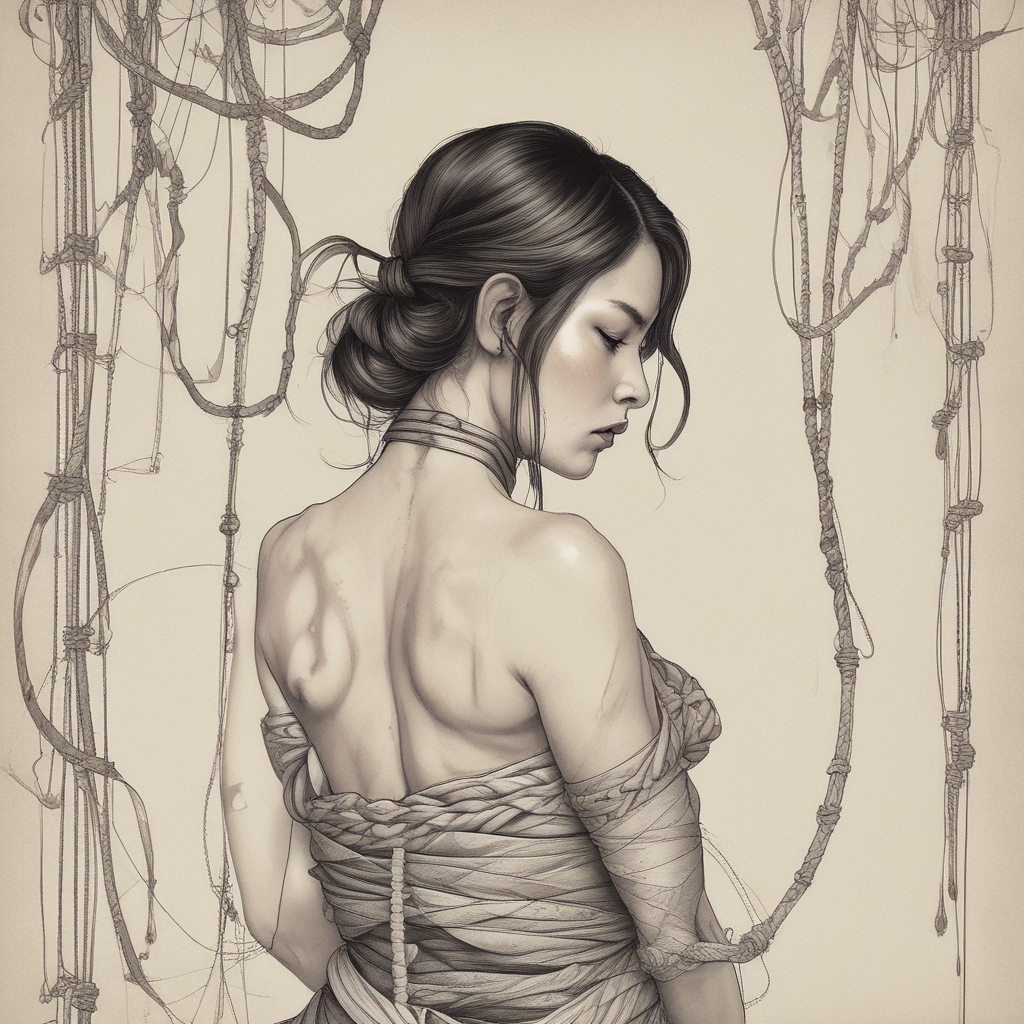Exploring the Art of Shibari: A Journey into Japanese Rope Bondage

Exploring the Art of Shibari: A Journey into Japanese Rope Bondage
The History and Evolution of Shibari: Delve into the origins of Japanese rope bondage, tracing its roots back to ancient Japan and exploring how it has evolved over time. Discuss the cultural and historical significance of Shibari, and how it has been portrayed in art, literature, and film
Shibari, also known as Japanese rope bondage, is a captivating art form that has gained immense popularity in recent years. This ancient practice, which dates back to the Edo period in Japan, involves the use of ropes to bind and restrain the body in intricate and visually stunning ways. In this article, we will delve into the origins of Shibari, explore its evolution over time, and examine its cultural and historical significance.
The roots of Shibari can be traced back to ancient Japan, where it was used as a form of punishment for criminals. The word “Shibari” itself comes from the Japanese word “shibaru,” which means “to tie.” During the Edo period, Shibari was also used as a form of erotic entertainment, with geishas and courtesans using it to arouse their clients.
However, it wasn’t until the 1970s that Shibari began to gain wider recognition as an art form. This was largely due to the work of Seiu Ito, a Japanese photographer who documented the practice in his book “Kinbaku: The Art of Rope Bondage.” Ito’s photographs, which featured models bound in intricate and beautiful ways, helped to popularize Shibari and bring it to a wider audience.
Since then, Shibari has continued to evolve and grow, with practitioners around the world exploring new techniques and pushing the boundaries of what is possible with rope. One of the most significant developments in recent years has been the emergence of Shibari as a form of performance art. Shows featuring Shibari have become increasingly popular, with performers using the art form to create stunning and visually stunning displays.
But Shibari is more than just a form of entertainment. It is also a deeply spiritual and emotional practice, with many practitioners describing it as a form of meditation or self-discovery. The act of binding and restraining the body can be incredibly intense and transformative, with many people reporting feelings of heightened awareness and connection to the world around them.
Shibari has also been portrayed in art, literature, and film, reflecting its cultural and historical significance. In Japanese art, Shibari has been depicted in paintings, sculptures, and other forms of visual art, often as a symbol of eroticism and sensuality. In literature, Shibari has been explored in novels, manga, and other forms of written media, with many authors using it as a metaphor for the human condition.
In film, Shibari has been featured in a number of movies and TV shows, often as a way of exploring themes of power, control, and submission. One of the most famous examples of Shibari in film is the 1998 movie “Secret Beyond the World,” which features a scene in which a woman is bound and suspended in mid-air using ropes.
In conclusion, Shibari is a fascinating and complex art form that has a rich history and cultural significance. From its origins as a form of punishment to its current status as a form of performance art and spiritual practice, Shibari has evolved and grown over time. As more people discover the beauty and intensity of this ancient practice, it is likely that Shibari will continue to evolve and grow, pushing the boundaries of what is possible and exploring new dimensions of human experience. Whether you are a practitioner, a spectator, or simply a curious observer, Shibari is a journey into the depths of the human soul, a journey that is both transformative and unforgettable.
The Techniques and Symbolism of Shibari: Explore the intricate knots and techniques used in Shibari, and the symbolic meanings behind them. Discuss the role of trust, communication, and consent in Shibari, and how it differs from other forms of BDSM
Shibari, also known as Japanese rope bondage, is a captivating art form that combines the beauty of intricate knots and the thrill of sensory deprivation. It is a form of BDSM (Bondage, Discipline, Sadism, and Masochism) that has gained immense popularity in recent years, not just for its aesthetic appeal but also for the deep emotional and psychological connections it fosters between partners.
At its core, Shibari is about the interplay between trust, communication, and consent. Unlike other forms of BDSM, which often involve the use of toys or implements, Shibari relies solely on the skillful manipulation of ropes to create intricate patterns and shapes on the body. This requires a high level of trust between the rigger (the person tying the ropes) and the model (the person being tied).
The rigging process itself is a deeply intimate and sensual experience, as the rigger’s touch and movements create a sense of connection and intimacy between the two partners. The model’s body becomes a canvas, and the ropes become a language, communicating the rigger’s intentions and desires.
One of the most striking aspects of Shibari is the intricate knots and techniques used to create complex patterns and shapes on the body. These knots, known as tsukami, are not just decorative but also serve a functional purpose, such as suspending the model in mid-air or restricting movement.
Each knot has its own symbolic meaning, reflecting the cultural and historical roots of Shibari. For example, the taut-line hitch, which creates a tight, diagonal line across the body, is said to represent the strength and resilience of the human spirit. The water knot, which creates a series of loops and twists, is said to represent the ebb and flow of the tides, symbolizing the cyclical nature of life.
The role of trust and communication in Shibari cannot be overstated. The model must trust the rigger to tie them safely and comfortably, while the rigger must communicate clearly and effectively to ensure that the model’s needs and limits are respected. This requires a high level of emotional intelligence and empathy, as well as a deep understanding of the model’s body and preferences.
The use of consent is also a crucial aspect of Shibari, as it ensures that both partners are fully engaged and invested in the experience. Consent is not just a legal requirement but also a moral imperative, as it allows both partners to fully explore their desires and limits in a safe and responsible manner.
In addition to its aesthetic and emotional appeal, Shibari also has significant psychological benefits. It can help to foster a sense of trust, intimacy, and connection between partners, as well as promote a deeper understanding of one’s own body and desires. It can also help to alleviate stress and anxiety, as the focus on the present moment and the sensory experience of the ropes can be deeply meditative and calming.
In conclusion, Shibari is a captivating and transformative art form that combines the beauty of intricate knots and the thrill of sensory deprivation. It is a deeply intimate and emotional experience, requiring trust, communication, and consent between partners. The intricate knots and techniques used in Shibari are not just decorative but also serve a functional purpose, reflecting the cultural and historical roots of this ancient art form. Whether you are a seasoned practitioner or a curious newcomer, Shibari is a journey into the depths of the human spirit, a celebration of the beauty and complexity of the human body, and a testament to the power of trust, communication, and consent.
The Artistry and Aesthetics of Shibari: Examine the beauty and artistry of Shibari, and how it has been celebrated in contemporary art and culture. Discuss the role of Shibari in fashion, photography, and other creative fields, and how it has been used to explore themes of identity, power, and transformation
Shibari, also known as Japanese rope bondage, is a captivating art form that has gained immense popularity in recent years. It is a form of erotic bondage that involves the use of ropes to tie and restrain the body in intricate and visually stunning patterns. Shibari is not just about the physical act of tying and untying ropes, but it is also a deeply spiritual and emotional experience that explores themes of power, trust, and intimacy.
The origins of Shibari can be traced back to the Edo period in Japan, where it was practiced as a form of erotic entertainment. However, it was not until the 1970s that Shibari began to emerge as a distinct art form. It was during this time that Seiu Ito, a Japanese photographer, began to document the practice and popularize it through his photographs.
Since then, Shibari has become a celebrated art form in contemporary culture, with its influence extending far beyond the realm of erotic entertainment. Shibari has been embraced by the fashion industry, with designers such as Alexander McQueen and Issey Miyake incorporating its intricate patterns and techniques into their collections. It has also been featured in high-end fashion shows, such as the one held by the French fashion house, Chanel, in 2013.
Shibari has also found its way into the world of photography, with renowned photographers such as Araki and Nobuyoshi Araki exploring its themes of power, intimacy, and transformation in their work. In fact, Araki’s book, “Sentimental Journey,” which features images of Shibari, is considered a seminal work in the genre.
The role of Shibari in contemporary art and culture is not just limited to fashion and photography, but it has also been used to explore themes of identity, power, and transformation. Shibari has been used as a form of self-expression by individuals who identify as part of the BDSM community, as a way to explore their sexuality and identity. It has also been used as a form of therapy, with practitioners using it to help individuals overcome trauma and develop a greater sense of self-awareness.
The beauty and artistry of Shibari lie not just in its intricate patterns and techniques, but also in the emotional and spiritual connection that it creates between the partners involved. Shibari is not just about the physical act of tying and untying ropes, but it is also a deeply spiritual and emotional experience that explores themes of trust, intimacy, and power.
In Shibari, the person being tied, known as the “model,” surrenders control to the person tying them, known as the “rigger.” This surrender of control is not just physical, but it is also emotional and spiritual. The model trusts the rigger to tie them in a way that is both safe and aesthetically pleasing, and the rigger takes on the responsibility of ensuring that the model’s needs are met.
The emotional and spiritual connection that is created between the partners involved in Shibari is what sets it apart from other forms of bondage. It is not just about the physical act of tying and untying ropes, but it is also about the emotional and spiritual connection that is created between the partners involved.
In conclusion, Shibari is a captivating art form that has gained immense popularity in recent years. It is not just about the physical act of tying and untying ropes, but it is also a deeply spiritual and emotional experience that explores themes of power, trust, and intimacy. Shibari has been embraced by the fashion industry, with its influence extending far beyond the realm of erotic entertainment. It has also been used to explore themes of identity, power, and transformation in contemporary art and culture. The beauty and artistry of Shibari lie not just in its intricate patterns and techniques, but also in the emotional and spiritual connection that it creates between the partners involved. Shibari is a celebration of the human body, a testament to the beauty and artistry of the human form, and a reminder of the power of connection and intimacy.





